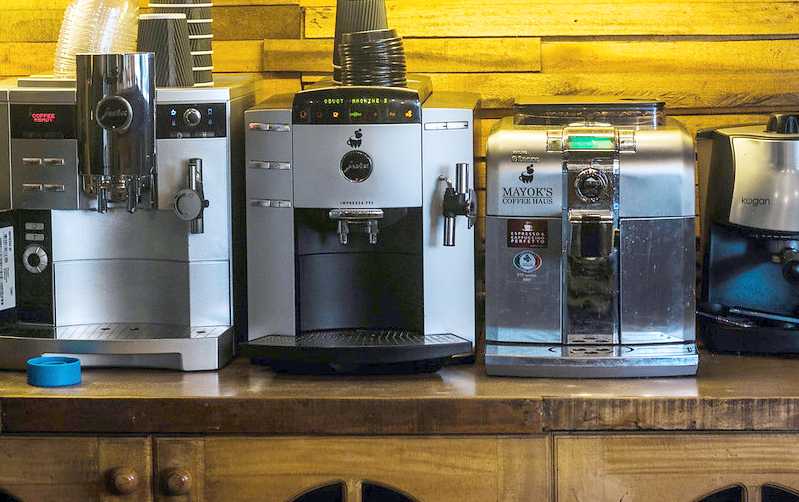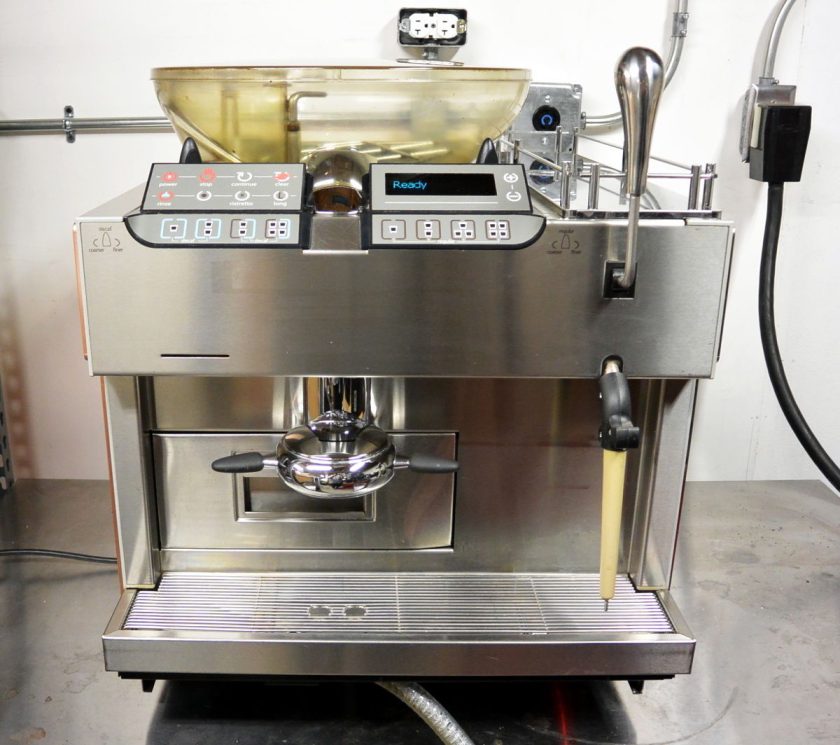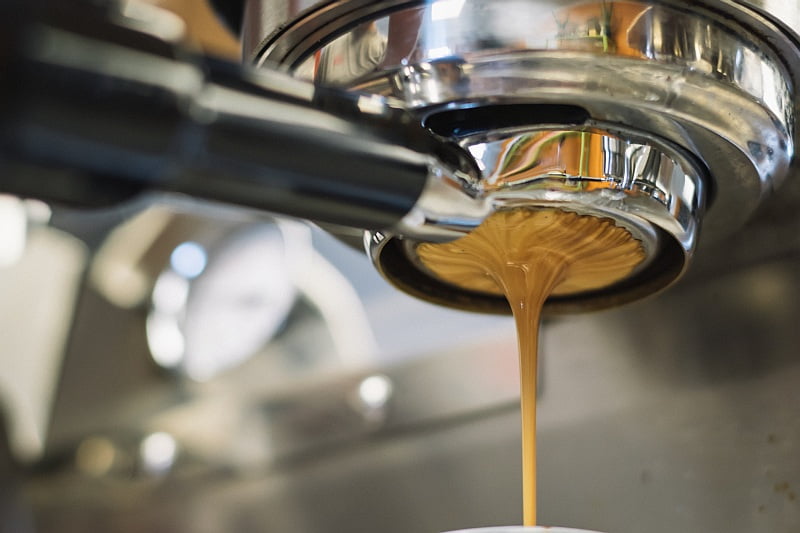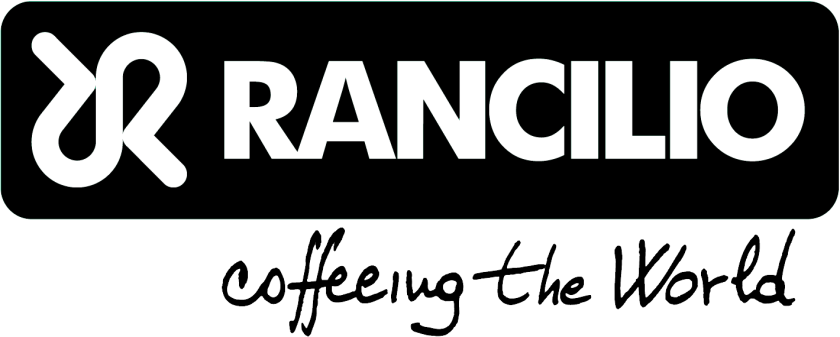When you are buying your first espresso machine, you are faced with a big problem: choice. There are so many choices, that even if it's your second espresso machine, it could prove a difficult task.
There are so many types of espresso machines, and there is a lot of competition on the market nowadays, that sometimes it's really difficult to choose, when you don't have all of the information. This is why we put together this espresso machine buying guide.
Even if you don't want to purchase soon, this page will show you what the differences between all the espresso machines are, and what importance have all the features for the barista.
What Is An Espresso Machine?
An espresso machine is a kitchen appliance that brews coffee by pushing nearly boiled pressurized water through a compressed puck of ground coffee. The result is a thick, concentrated coffee going under the name of espresso.

An espresso maker has several parts that vary from one machine to another, but there are some parts that will always remain constant: the pump, the boiler, the grouphead, and the filter.
The boiler is the component that heats the water, the grouphead delivers water into the filter, the pump creates the brewing pressure, and the filter is where the ground coffee is brewed and filtered. Here is a dictionary of espresso machine parts, if you want to learn more.
In order to qualify as an espresso machine, the appliance needs to be able to create pressure for the brewing process. Although many times people refer to stronger coffee as espresso, this is not a correct denomination. We cannot make coffee in a coffee machine, or in a French press. But more on the subject here: What Is Espresso?
We will get back later in the article with more info on the different espresso machine types.
What to Look for when Choosing an Espresso Machine – Espresso Machine Components
If your objective is to get the best inexpensive machine, you can stop reading here. But if you want a great espresso machine that will serve your needs you will have to do a bit of homework.
We also focus here on pump-driven machines, although technically steam-driven machines would qualify.
Our guide will show you what are the most important things to consider when buying an espresso machine, whether you want coffee shop quality espresso shots and coffee drinks, or you chase the perfect espresso shot.
Let's dive in and look at the options when choosing a machine, and what the optional features can do for as as home baristas.
Portafilter
Semi-automatic models also use different styles of portafilters. The low end almost always use pressurized filter-baskets in their portafilters. Pressurized baskets create faux crema, and give the home barista the false impression that they pulled a great shot. Non-pressurized baskets allow you to perfect your technique, and to pull great shots.
Pressurized baskets are for beginners who just want a strong cup of coffee, and the flavors are not as important as the convenience.
The other portafilter classification is by basket diameter. There are various basket diameters, but in my experience, for those who aim espresso greatness, the 58 mm portafilter is the best.
Boiler
The boiler is also something you would want to look for. The best boilers are made from brass, and the larger the boiler, the more water you have warm, so more shots back-to-back.
A dual boiler machine such as Silvia Pro will allow you to pull shots and steam milk at the same time, which you cannot do with a single boiler. But a dual boiler machine is much more expensive than a single boiler one.
The boiler capacity is also something to think about, if you need to pull shots back to back. Anything over 10 oz. capacity is a decent size for a domestic machine.
Some machines are equipped with thermoblock, instead of a boiler. While the thermoblock is not a bad solution, you would need an expensive thermoblock machine to be as precise as a boiler machine, given that we have a good temperature control system on both solutions. Someone on Reddit explained this better than I would.
When choosing a machine, the boiler is one of the key components, especially if you make a lot of milk-based drinks such as cappuccino and flat white. Machines with a single boiler are great for pulling espresso, but they pose problems when making more than one milk-based drink at a time.
The problem is that brewing espresso and steaming milk need different temperatures, so you will need to wait between the espresso shot and the milk frothing, so that the boiler reaches the correct temperature for steaming. The internal temperature of the boiler for brewing espresso is around 201°F. The boiler internal temperature for steaming milk is between 252°F and 262°F. So imagine if you need to prepare a few lattes back-to-back. Wait for the boiler to warm up to 201°F, pull the espresso, then wait for the boiler to warm up to 252°F. That is for one latte. Then wait for the boiler to cool down from 252°F to 201°F to pull and espresso, then wait again for the boiler to warm up to 252°F.
Temperature control
Espresso is a very precise brewing method, and the extraction temperature is of the utmost importance. Inexpensive machines will have a built-in thermostat that will stop the heating element when the water in the boiler reached the optimal temperature.
The problem with this solution is that the machine's components have thermal inertia. They will transfer heat even when the thermostat shuts down the heating element. This means that the boiler get over-heated, and it goes over the optimal temperature.
This problem is solved with a PID. The PID is a better temperature control solution, that will adjust down the heating amount increments, as it gets closer to the target temperature. This way, the over-heating will be negligible.
This is one of the features you want on your espresso machine if you are serious about the taste of your shots.
Pressure Gauge
The pressure gauge is one of the nice to have, as it allows you to read the pressure in the shots as they pour. It is not an absolute need, as the pouring volume will approximate the pressure decently.
Pre – Infusion Function
The pre-infusion will allow a better saturation for the coffee grounds with water. This, in turn, will avoid channeling, and improve extraction. Pre – infusion is a function on the espresso machine, and it's usually found on more expensive equipment.
Steam Wand
The steam wand is a small, solid-metal pipe, like an arm sticking out of the machine, typically located near the group or coffee head. The attached arm forces steam into the milk and gently warms it under pressure. It also adds air to the milk which makes it foam.
The metal pipe has a certain mobility, which vary from machine to machine, and the ones that are not that mobile will inconvenience you for the entire life of your machine, so choose wisely.
Some super-automatics come with a steam wand, and only the espresso brewing function is fully automatic. If you want a no-hands milk steaming machine, this is an added cost.
Depending on what drinks you like, you might want to choose between a classic steam wand tip and an auto-frother tip, or a panarello. The panarello is a froth enhancement system that will inject more air in the milk, to help the beginner barista get textured milk for cappuccino.
If you make more lattes than cappuccinos, you will need steamed milk. That means you'll want the classic steam wand tip, but it does require a bit more skills and practice. For a flat white, your textured milk is somewhere between cappuccino and latte. A lot of microfoam steamed milk, which gives the flat white its distinctive mouthfeel, and it allows the barista create beautiful latte art designs.
Coffee Grinder
Automatic and super-automatic machines come with a built in grinder. The quality of this grinder will make or break your espresso shot.
Typically, the ceramic burr grinders are quieter than the ones equipped with steel conical burrs.
The ability to fine tune your grind size very precisely might be something to look for if you are going for absolute perfection in your espresso shots.
The Pump
There is not much you can control about the pump in your espresso machine. The standard in espresso today is 9 bars of pressure, normalized. That means that most machines will have an over-pressure valve that opens if the pressure goes beyond 9 bar.
You will see a lot of manufacturers advertising machines equipped with 15 bar pumps. Not much of an advantage, besides perhaps reliability. Running a 15 bar capable pump at 9 bars of pressure will perhaps put less stress on the pump. But if the pump quality is bad, this won't matter. So maybe stick to getting stats about the machine's reliability instead of choosing an oversized pump.
In home espresso, there are two categories of electric pump: the vibratory pump and the rotary vane pump.
Vibratory Pumps are inexpensive, easy to replace and small. They are louder than rotary pumps, and have a shorter lifespan in comparison. Rotary Pump are a bit more expensive but they last longer and operate quietly compared to the vibe pumps. They are larger, so they will automatically need more space inside the espresso machine.
The Brew Group
The brew group is the combination of parts where espresso gets extracted, including the brew head, the portafilter, and sometimes other temperature control components. The brew group is mostly discussed in the semiautomatic machine context, since the super-automatic machines have proprietary designs, and choosing one model versus another is not easy.
Water Reservoir
Although not the most important piece of an espresso machine, the water tank can make your barista life miserable.
If your selection process is down to the difference between water reservoirs, here are a few things you should consider. The size of the reservoir is important especially if you brew many drinks. Imagine having to refill the tank every two or three days. My machine has a large capacity reservoir, and I still complain about having to refill it.
Still related to water tank refilling, the access to the tank is important. If you have to access the tank from the top, and you plan to stick your espresso machine under your cabinets, you will have to pull the machine out every time you need to refill. This is easily fixable with a glass microwave oven tray under the machine, to make it slide out easily. However, not everybody wants that type of setup.
Most commercial machines don't have a water tank, you will have to connect them to the water line.
The Machine's Size
I mentioned the size already but in the context of the reservoir. My point is, make sure you measure three times and purchase once.
Drip Tray
The removable drip tray is often ignored, as being less important for a home barista setup. If you think you will pull many shots at once, a small drip tray will need emptying more often. Not the end of the world, but still something to consider.
Commercial Machines vs Domestic Machines
This might be obvious to some, be here what the differences are in case you are considering getting a commercial machine.
First, let me make it clear, fi you need more than a few shots of espresso per day, and a few milk beverages, you should consider a commercial machine.
Domestic machines are made cheaply. They are built with inexpensive materials in order to cut costs and improve affordability. The typically are smaller machines, with small boilers and inexpensive pumps.
On the other hand, commercial espresso machines are built to sustain intensive use, the type of use you would find in a commercial setting such as a coffee shop, a bar, or a restaurant.
If you are buying this machine for an office, you will have to buy a commercial machine. Some manufacturers have warranty clauses against over use of the domestic machines. So if the machine breaks, you are on your own.
However, if you want a great machine for domestic use, there is nothing holding from getting a commercial model. You will pay more as the initial investment, and your electricity bills will be higher, but your coffee making experience will be great.
Types Of Espresso Machines
There are several types of espresso machines, each of them serving a different purpose and featuring a different way of functioning. The way you plan on using said machine will dictate the type that you buy.
Before settling on an espresso machine type, think more about what you need from it, and less about the price.
Semi-Automatic Espresso Machine
Semi-automatic espresso machines are the most common on the market since for two reasons.

Firstly, a basic semi-automatic machine is very cheap, compared automatic machines, since it's very simple machine. If this is what you are looking for, we have here a list with the best cheap espresso machines on the market.
Secondly, semi-automatic machines appeal to baristas who need perfection. Advanced semi-automatics include various features that allow baristas to tweak brewing variables to the last details. This flexibility helps them aim for perfect espresso shots.
Preparing an espresso shot with a semi-automatic espresso machine requires the barista knowledge, skills, and desire to do things more or less manually. Many times semi-automatics are called manual, because of the manual work required from the barista, but that the wrong name. We will talk about manual espresso machines later in the article.
Here's in more detail what semi-automatic espresso maker brings to the table:
- Relatively easy to use, but you still need to learn to operate them, and at least get some basic espresso brewing knowledge.
- Offers great brewing flexibility for those who want to play with brewing variables for tweaking their coffee.
- The machinery is generally very simple, with no complicated internal boards. This means reliability.
- Generally less expensive than automatic espresso machines, but they can get more expensive as you want more from them.
Super-Automatic Espresso Machine
The super-automatic espresso maker is like an automatic machine – only on a super level. Unlike automatic machines, this one also incorporates a self-grinder, which means you also won't have to bother grinding the beans yourself.

They work similarly to semi-automatic espresso machines – only instead of putting the coffee grounds in the portafilter, you'll put the beans in the grinder.
The machine will then proceed to grind the beans, transfer them into a filter basket, and then brew the desired volume of your espresso into the cup.
Now comes the question: why would I need a super-automatic machine when I could go for much cheaper semi-automatic ones? Well, the deciding factor here is how picky you are about your espresso aroma.
It's a known fact that freshly ground coffee is more aromatic, resulting in a better tasting coffee. A super-automatic coffee machine is by definition convenience oriented. As such, people are tempted to fill the bean hopper with coffee beans for a few days. We should resist that temptation, if we aim for the best espresso ever. Coffee lovers go the extra length to ensure the best storage for their coffee beans. It does take away from the convenience aspect if we have to fill the hopper every day, but espresso is not all about convenience.
Here are some key points that you might want to consider about the super-automatic coffee makers:
- They're very easy to use, with no special skills or practice required. All you have to do is fill the spaces for the water and coffee grounds, and then you press a button.
- Every super-automatic espresso machine will produce great-tasting espresso, provided you use high-quality coffee beans.
- They have fewer brewing adjustments, but that depends on the models that you purchase. Some new models may allow you to control the temperature of the espresso, as well as the volume and other features.
- They usually need more counter space, but that is only because they have more internal features to produce fresh coffee.
- The price range is generally right under $400.
The best espresso machine under $500 is usually a high-quality super-automatic machine. Some of the most appreciated models include the De'Longhi espresso machine, which is famous for the fact that it is very easy to use.
Automatic Espresso Machine
Automatic espresso machines will automate the “brewed volume,” therefore immediately and indirectly affecting the brewing time. The tamping and grinding will, however, remain manual.
These machines work by adding a flow meter at the group head, which will “sense” the stage of the espresso. Once the programmed water amount will go through said meter, the pump will be automatically turned off.
Here are some key points of the automatic coffee machine:
- It doesn't require much human intervention, but you also can't really customize your drink
- They're cost and time-effective
- They're easy to use and turn espresso-making into a simple process
- Maintenance is fairly simple
Sometimes, an automatic espresso machine will also have semi-automatic controls which allow you to customize the type of coffee that you want.
Manual Espresso Machine
A manual espresso maker is a perfect thing for those “old souls” that want to keep the tradition in the coffee making.

Also known as the lever espresso machine, they will require a great degree of skill – since you will basically have to brew the coffee yourself. With this type of machine, there's no pushing of a button; instead, there's the pressing of a lever.
This type of espresso maker will allow you to become part of the process, which is a truly rewarding experience if you enjoy doing things yourself.
Plus, you have full freedom to customize the drink however you want. With a little bit of practice, you will know exactly what it takes to blend the perfect espresso for your taste.
You can go for stove types as well when it comes to manual espresso makers. It's pretty much the “middle way” between pot-brewed coffee and machine-made espresso.
Here are the key points for a manual espresso maker:
- Classy, traditional design
- Mechanically simple, without any complicated boards
- Generally requires little space on the counter
- Fairly expensive ($800 and up), but they are the most durable of the batch
- They are more complicated to use since they require experience in coffee brewing
Capsule Espresso Machines
Capsule machines offer convenience above all. The espresso shot is standardized and you can't go wrong. It is the ultimate espresso consistency solution. But this consistency comes at a price.
With capsule based espresso machines you are limited to the manufacturer's coffee selection.
The capsule machines are not particularly expensive, but the espresso capsules for them is. In time, you will pay for the convenience more than you expect. The more coffee you make with it, the more expensive it gets. If you like to drink to double shots per day, please make the math before buying it as an inexpensive solution.
Capsule machines are made compact, and they don't have a steam wand, because the technology doesn't support one. So if you need espresso only, you are fine, but if you love lattes, cappuccinos, and other milk drinks, you will have to buy a separate milk steamer/frother.
The technology for the capsule based espresso is different from company to company. So much so, that most of the solutions taste different than espresso from a regular machine. It's not worse, or better than espresso. It's just different.
How to Pick a Domestic Espresso Machine

At this point you have a lot of information about the various types of espresso machines, and about the various optional features they might have. How do you put all that information to use, and make a choice though?
In the end all comes down to a few criteria which sometimes are mutually exclusive, but not necessarily. This means you might not get what you need and want, and you'd have to settle for the next best solution. For instance, a low budget won't get you a fully featured espresso machine, which is very expensive. Similarly, a capsule based espresso machine won't get you control of the brewing variables to tweak your coffee for the perfect shot of espresso.
Espresso Machine Manufacturers
Some manufacturers are more popular than others, and when it comes to brewing espresso, these are the brands that seem to do the best jobs:
Breville
Breville is an Australian brand of home appliances, founded in 1932. Their espresso machine line is aimed at the domestic sector, and include famous espresso machines such as the Oracle, and the Breville Barista Express. They also make Nespresso coffee machines such as the “Creatista”, “Inissia”, and “Vertuo”. More Breville tagged posts.

They also have a Breville espresso machine under 500 dollars, which is why it's so popular among the masses.
Rancilio
Founded by Robert Rancilio in 1927, the brand started off manufacturing commercial espresso machines. The Rancilio Silvia was a lucky strike in the domestic espresso machine market, and they realized the potential and started to aim this market just recently. More Rancilio posts.

Gaggia
The Gaggia espresso machine is generally automatic, with controls that are very easy to use. Started by Achille Gaggia, the purpose of the machine was to be as simple and fine as possible to enable easy use.
The company was also the first one to introduce the piston lever espresso maker, which is why he was hailed as the Father of the modern espresso maker.
We thing they are a great espresso manufacturer and we wrote a few pieces that include Gaggia equipment. Here are our posts tagged as Gaggia.

Mr. Coffee
Mr. Coffee is popular for the fact that they produce decent espresso makers at low prices. The Mr. Coffee espresso machine generally functions on a 3-in-1 system, allowing you to make lattes, espressos and cappuccinos easily. Here is our content tagged as Mr. Coffee.

They are also very easy to disassemble, so if you dislike the hassle of brewing and cleaning, this one is the brand for you.
De'Longhi
No matter if you are looking for a super-automatic espresso maker or a manual device, De'Longhi has a model for everything. De'Longhi has probably more domestic models than most espresso manufacturers, trying to appeal to all home baristas. The greatest thing is that their machines are pretty reliable. Here are our posts tagged De'Longhi.

Final Thoughts
Owning a coffee machine can literally be a matter of life and death – or at least a matter of sanity. For a coffee addict connoisseur, it's impossible to start the day without at least one cup. It's a proven fact that coffee makes people happy.
This is exactly why you need to be careful when choosing your espresso maker. You need to read as many espresso machine reviews as possible and form an opinion for yourself.
If you read the above guide and are still not sure what is the best coffee machine, you are more than welcome to read our buying guide. We listed some very useful tips for you in there as well.
